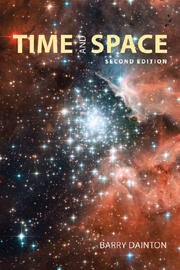Book contents
- Frontmatter
- Contents
- Preface to the second edition
- Preface to the first edition
- 1 Preliminaries
- 2 McTaggart on time's unreality
- 3 The Block universe
- 4 Asymmetries within time
- 5 Tensed time
- 6 Dynamic time
- 7 Time and consciousness
- 8 Time travel
- 9 Conceptions of void
- 10 Space: the classical debate
- 11 Absolute motion
- 12 Motion in spacetime
- 13 Curved space
- 14 Tangible space
- 15 Spatial anti-realism
- 16 Zeno and the continuum I
- 17 Zeno and the continuum II
- 18 Special relativity
- 19 Relativity and reality
- 20 General relativity
- 21 Spacetime metaphysics
- 22 Strings
- Notes
- Glossary
- Web resources
- Bibliography
- Index
13 - Curved space
- Frontmatter
- Contents
- Preface to the second edition
- Preface to the first edition
- 1 Preliminaries
- 2 McTaggart on time's unreality
- 3 The Block universe
- 4 Asymmetries within time
- 5 Tensed time
- 6 Dynamic time
- 7 Time and consciousness
- 8 Time travel
- 9 Conceptions of void
- 10 Space: the classical debate
- 11 Absolute motion
- 12 Motion in spacetime
- 13 Curved space
- 14 Tangible space
- 15 Spatial anti-realism
- 16 Zeno and the continuum I
- 17 Zeno and the continuum II
- 18 Special relativity
- 19 Relativity and reality
- 20 General relativity
- 21 Spacetime metaphysics
- 22 Strings
- Notes
- Glossary
- Web resources
- Bibliography
- Index
Summary
New angles on old problems
We may have pursued the classical debate on space and motion a good way beyond its original boundaries, but there are further modifications to the classical worldview of a still more fundamental kind that we have yet to explore. Viewing motion as a process unfolding in spacetime does not require or involve the abandonment of the classical conception of space as a three-dimensional Euclidean structure, and the various spacetimes we have considered thus far retained this conception of space: there are no spatial distances over time in neo-Newtonian worlds, but the spaces-at-times that remain are entirely Euclidean. The spacetime perspective came into its own when Minkowski gave a spacetime interpretation of Einstein's special theory of relativity in 1908, but significant advances in the understanding of space – advances that play a crucial role in Einstein's general theory of relativity – had already occurred. By the middle of the nineteenth century it had become clear to mathematicians that space can take different forms and that the structure of Euclidean space is just one spatial structure among many.
This discovery gave rise to new questions: what sort of space do we live in and how can we find out? It also transforms the debate between substantivalists and relationists, as we shall see in Chapter 14. However, before entering these debates we need to know something about these strange non-classical, non-Euclidean curved spaces, and this chapter is devoted to this end (and so can safely be skipped by those already familiar with the basics).
Information
- Type
- Chapter
- Information
- Time and Space , pp. 213 - 232Publisher: Acumen PublishingPrint publication year: 2010
